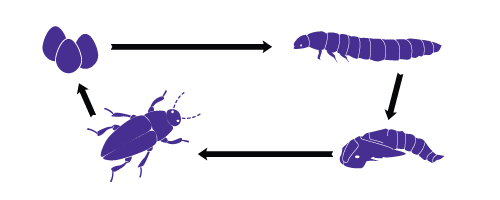How to get the most out of your mealworms
Posted by Jessica Manafi on Jul 24th 2018
Bluebirds can be a sight to watch. They’re often admired for their soft coloring and distinctive song making, and luring them to your garden is as easy as providing a simple snack made up of mealworms.
So what are those small, brownish insects that are used often in ornithic or reptilian diets and that have even gained popularity by way of human consumption?
Contrary to what they are commonly known as, mealworms aren’t actually worms. These one-inch insects are actually worm-like larvae of Tenebrio Molitor, a species of darkling beetles.
A darkling beetle experiences four distinct stages of life: egg, larva, pupa, and adult. The amount of time a darkling beetle spends in each stage can vary greatly due to environmental factors like temperature, humidity, food, and water. Mealworms are found at the second stage and exist to eat and grow until they have enough energy stored to begin transformation into pupae.
These insects are an important part of our ecosystem and are commonly found throughout most of the world in warm, dark, and damp places like under decaying logs and leaves. They are genetically designed for burrowing and eating and will feast upon grains, vegetation, spoiled food, and many other types of fresh or decaying organic matter.
Mealworms’ voracious eating habits aid in the decomposition and cleanup of unwanted organic matter, and with their high protein and fat levels, they’re also popular feeder insects for bearded dragons, bluebirds, chickens, fish, and many other animals.
“For animal owners, they’re popular because they are very easy to raise in captivity compared to a lot of other insects that (Fluker’s) has,” said Kim Boykin, a Louisiana State University researcher. “There’s little hassle to them, and they aren’t smelly, like crickets, which is a popular reason for buying them.
“For the animals, they move around the cage fairly well and draw interest,” she added. “The reptiles are activated by the motion of them, and they are generally pretty easy to eat.”
Boykin warned that because of the mealworm’s higher fat content, there should be a variation in the animal’s diet. However, they do offer nutrients that the reptiles need. Mealworms are good for water-soluble vitamins and for most of the mineral content, but they do lack calcium, which needs to be supplemented.
Fluker’s Cricket Farms has been a premiere supplier of high quality mealworms for the past 65 years and sells live mealworms in various quantities, ranging from 250 to 10,000 insects per order.
“(Your order size) should depend on the size of your animal,” said Casey Barthe, Fluker’s reptile specialist. “A little gecko is only going to eat one or two a day, but something larger, like a bearded dragon or a chameleon, can eat up to 30 or 50 a day.”
In addition, the quantity you order should also be determined by your storage space. Mealworms can be easily maintained for long periods of time if stored properly.When ordering your mealworms from Fluker’s, you can expect them to be delivered loose in either a box or mailing tube depending on the quantity ordered. Upon arrival, immediately place the insects inside a plastic container with air holes and cover them with a two-inch layer of wheat middling or oatmeal to provide bedding and a food source. Then transfer the container to a refrigerator set at 45 to 50 degrees Fahrenheit. The mealworms will go into a hibernated state but will continue to thrive in the environment.
It’s important to know that when storing the insects for an extended period of time, you should provide a water source every two weeks by removing them from the refrigerator, allowing them to warm up for an hour, and then placing thin slices of potatoes or carrots on top of the bedding for consumption. After a couple of hours, discard any leftover chunks and return the container back to the refrigerator.
“Just make sure to gut-load them really well with plenty of fresh vegetables, like carrots or greens, to maximize their nutrition, so they are nice and full of nutrients,” Barthe said.
Taking care of your feeder insects will help keep them healthy and in turn will lead to a healthier pet.




